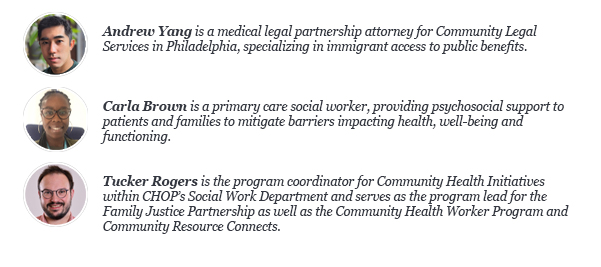The Medical Legal Partnership Model: A Holistic Approach to Family Well-being


We know that a person’s well-being depends on more than biological factors that can be measured by an x-ray or stopped by an antibiotic. It also depends on their social and economic circumstances—for instance, how accessible healthy food is to them, whether they can afford to heat their home, or address unsafe conditions like chipping lead-based paint. Children’s Hospital of Philadelphia’s Family Justice Partnership (CHOP FJP), a medical legal partnership (MLP), seeks to help address all of these needs. In this post we will explore how an MLP functions, how to measure an MLP’s impact and how an MLP integrates social work.
How does a medical legal partnership work?
A unique feature of the MLP model is that it looks at well-being through a holistic lens. The MLP considers both the individual and their circumstances; both a person’s biological health and their social and legal context.
CHOP began an MLP pilot in 2015, which has since grown into a multi-partner effort with the University of Pennsylvania Law School’s Interdisciplinary Child Advocacy Clinic (ICAC) and Community Legal Services of Philadelphia (CLS). Now known as the CHOP FJP, we connect families to free legal services when they experience issues that impact children’s health and well-being, offer collaborative learning opportunities for medical, social work, and community legal partners, and advocate for institutional and structural policy change grounded in community engagement that aims to achieve equitable health outcomes for children and families.
Research shows that 47% of low-income and 52% of moderate-income households have at least one unmet legal need, and it is estimated that at least 60% of health outcomes are attributable to forces outside of the traditional health care system. The MLP model embeds lawyers into health care settings to support patients and their families with critical legal needs. The acronym traditionally used to describe the types of legal needs the model helps address is I-HELP, which stands for Income support, Housing and utilities, Education and employment, Legal status, and Personal family and stability.
Keeping this mind, we should emphasize that each MLP is unique. Some handle a wide variety of legal issues, while others only handle certain types of cases. For instance, the MLP at CHOP’s Karabots Pediatric Care Center in West Philadelphia began with a housing focus, reflecting the unique needs of West Philadelphia and its aging housing stock. Meanwhile, the MLP at CHOP South Philadelphia aims to address legal issues specific to the neighborhood’s immigrant and refugee population.
Ideally, an MLP site will focus on providing health-related legal services most needed in the community. This is often determined by conducting a needs assessment in the pilot stage of a program, but beyond that, requires consistent communication with neighborhood partners, patients and local organizations.
What do we know about the impact of medical legal partnerships?
Summarizing the available evidence, the National Center for Medical Legal Partnership highlights that MLPs have been shown to improve health in asthma patients, support families of newborns in increased uptake of preventive health care, save patients money on their health care costs and help them to recover cash benefits.
Specific to an MLP in a pediatric health care setting, a 2022 Health Affairs study showed that patients and their families who were referred to Cincinnati Children’s MLP, Child HeLP, for any level of legal intervention had 37.9% fewer hospitalizations in the subsequent 12 months. The study showed that addressing the root causes of ill health, like housing issues, resulted in a substantially reduced need “downstream” for emergency interventions.
In our CHOP MLPs, we take both a quantitative and qualitative approach to understand how we can best meet the needs of families. We keep track of when a patient is officially referred to the MLP, the type of assistance they receive, and the outcomes and financial benefits of legal intervention, as well as consensually obtain client stories. Our hope is that we can measure the effectiveness of this type of holistic intervention on the client’s well-being, its impact on the surrounding community, and in the future, contribute to the growing body of evidence on the impact of the MLP model.
Understanding the important partnership between an MLP and social work services
When applying a holistic lens, an MLP blurs the normally bright lines between different modalities (e.g., “the medical” and “the legal”). This dynamic creates tension—an MLP’s overall approach is holistic, but by necessity distinctions need to be drawn so that different partners in the MLP can contribute their expertise to the whole person. Social work and assessment can be important resources in drawing these distinctions.
In primary care, social workers collaborate with medical staff to allow providers to prioritize the medical care of patients, while they focus on psychosocial barriers to care such as food and housing insecurity, behavioral health and relational concerns, systems barriers, and challenges accessing public benefits. Through this approach, a social worker can act as a bridge between social and medical care and can engage the legal side of the MLP when appropriate.
At the CHOP Karabots MLP, the social worker screens for relevant legal concerns with caregivers, while also identifying the measures a family has taken to address their needs prior to medical staff awareness. This assessment takes a comprehensive view of the family’s psycho-social-spiritual situation, identifying a family’s strengths, barriers, preferences and resources. The social worker may then refer the patient to the legal side of the MLP for support addressing unmet needs.
Once referred, if other barriers prevent a client from fully engaging with the MLP, the social worker can act as an additional support to make sure they remain engaged and receive help. Documentation created by social work can support connection between environmental and social factors that may be impacting patient health once a patient is engaged with legal staff in the MLP.
The partnership between legal staff and social work brings the patient’s care closer to the holistic ideal of the MLP. Over time, a lawyer or paralegal might find themselves thinking more like a social worker, while a social worker might find themselves weighing legal outcomes when considering a case—unfamiliar territory for both, but a necessity of the close collaboration. Ongoing communication and education fosters this interdisciplinary exchange and is necessary for the success of the MLP.
Sustainability, growth and the future of MLPs
Historically, MLPs in the United States have been funded through philanthropy, as well as health care and legal funding sources, creating a patchwork of funding. As the model matures, and the body of evidence on its positive impact on family well-being continues to grow, additional funding streams are needed to expand and sustain the MLP model. This work will require investments from outside of philanthropy, including looking to greater health care institutional investment as well as opportunities through Medicaid managed care organizations or Medicaid 1115 waivers.
We are excited about the growing recognition of the MLP model, and hope for a future where every health system can deploy an MLP to advance equity and serve the legal needs of patients across the country.

